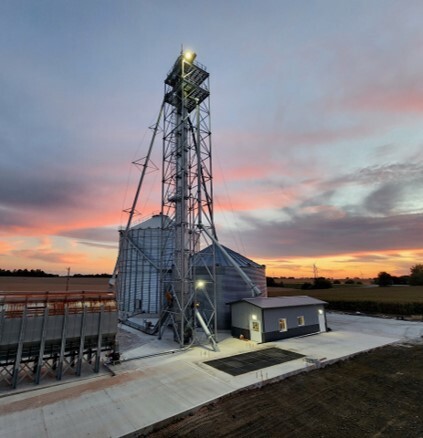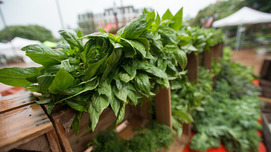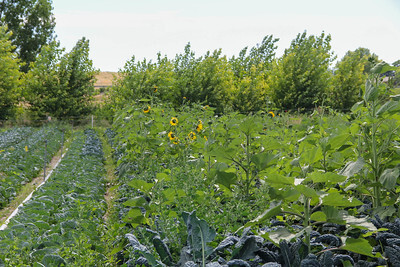
Is there anything that goes better together in August in Indiana – than the Indiana State Fair and Basketball? I don’t think so either!
As students across this state are making their journey back into the classroom, so are many fairgoers and livestock exhibitors traveling to Indianapolis to attend the greatest State Fair in the country!
The uniqueness of a themed state fair – this year is “The State That Grew the Game” – makes it extra special to celebrate agriculture, basketball, farm families and 4-Hers during the 18-day run of the fair. Agriculture is the focal point of the fair, and this year the fair celebrates the opening of the Indiana Farm Bureau Fall Creek Pavilion, or as we all know it, the new Swine Barn. The architects and contractors knocked the layout of the barn out of the park with the 117,000-square-foot show floor, 1,400 livestock pens, two show rings and seating for more than 1,100 people. The climate controlled, multiuse building retained its ornate brick-facade from the original Swine Barn and integrated it into the new construction. The 1,400-square-foot lobby will house a permanent agricultural exhibit so the story of modern agricultural production can be told as the pavilion is transformed for other events throughout the year.
Indiana FSA staff participate in state fair activities during the month of August, by partnering with the beef, pork and dairy associations in working their food stands, and volunteering in the Glass Barn, a permanent building on the fairgrounds, provided by Indiana Corn and Soybean farmers. As part of the Indiana Conservation Partnership, FSA staff work shifts at the Pathway to Water Quality on the east side of the fairgrounds to educate fairgoers about the importance of conservation practices and water quality in the state of Indiana. Throughout the fair, FSA staff meet with policymakers, stakeholder groups, and farmers to learn from and share information about the USDA Farm Service Agency.
As I think about the theme of the fair, I cannot help but reflect on the great ‘bench’ that Indiana FSA has as we team up to provide commodity, conservation, credit and disaster assistance to help ensure a safe, affordable, abundant and nutritious food, fiber, fuel and feed supply in our country. If our ‘bench of players’ can help you, stop by and see them in your local office today.
Proudly Serving Agriculture,
|
 State Executive Director
Farmers may now utilize USDA's new online tool to help them better navigate the farm loan application process. This uniform application process will help to ensure all farm loan applicants receive equal support and have a consistent customer experience with USDA’s Farm Service Agency (FSA) regardless of their individual circumstances.
USDA experiences a high rate of incomplete or withdrawn applications, particularly among underserved customers, due in part to a challenging and lengthy paper-based application process. The Loan Assistance Tool is available 24/7 and gives customers an online step-by-step guide that supplements the support they receive when working in person with a USDA employee, providing materials that may help an applicant prepare their loan application in one tool.
Farmers can access the Loan Assistance Tool by visiting farmers.gov/farm-loan-assistance-tool and clicking the ‘Get Started’ button. From here they can follow the prompts to complete the Eligibility Self-Assessment and start the farm loan journey. The tool is built to run on any modern browser like Chrome, Edge, Firefox, or the Safari browser, and is fully functional on mobile devices. It does not work in Internet Explorer.
The Loan Assistance Tool is the first of multiple farm loan process improvements that are or will be available to USDA customers on farmers.gov in the future. Another such improvement is the Simplified Direct Loan Application which reduced the application from 29 pages to 13 pages.
Additional improvements and tools that are anticipated to launch in 2023 include:
- An interactive online direct loan application that gives customers a paperless and electronic signature option, along with the ability to attach supporting documents such as tax returns.
- An online direct loan repayment feature that relieves borrowers from the necessity of calling, mailing, or visiting a local Service Center to pay a loan installment.
Background
USDA provides access to credit to approximately 115,000 producers who cannot obtain sufficient commercial credit through direct and guaranteed farm loans. With the funds and direction Congress provided in Section 22006 of the Inflation Reduction Act, USDA is taking action to immediately provide relief to qualifying distressed borrowers whose operations are at financial risk while working on making transformational changes to loan servicing so that borrowers are provided the flexibility and opportunities needed to address the inherent risks and unpredictability associated with agricultural operations.
The application period is now open for a new financial assistance program under Section 22007 of the Inflation Reduction Act (IRA), for farmers and forest landowners who experienced discrimination in USDA farm lending programs prior to January 2021. The application process will close on October 31. Borrowers will have the option to apply for assistance online via 22007apply.gov or through a paper-based form.
Details about the program, including an application and e-filing portal, are available at 22007apply.gov. The website includes an English and Spanish language application that applicants can download or submit via an e-filing portal, information on how to obtain technical assistance in-person or virtually, and additional resources and details about the program. Applicants can also call the free call center at 1-800-721-0970 or visit one of several dozen brick-and-mortar offices the program has set up around the country. Locations are provided on the program website and vendors will update the local events schedule with more information as it becomes available. It is important to note that filing an application is FREE and does not require a lawyer.
If you want to get weekly updates on the program’s events and progress, you can go to 22007apply.gov, and subscribe to a weekly newsletter.

The National Environmental Policy Act (NEPA) requires Federal agencies to consider all potential environmental impacts for federally funded projects before the project is approved.
For all Farm Service Agency (FSA) programs, an environmental review must be completed before actions are approved, such as site preparation or ground disturbance. These programs include, but are not limited to, the Emergency Conservation Program (ECP), Farm Storage Facility Loan (FSFL) program and farm loans. If project implementation begins before FSA has completed an environmental review, the request will be denied. Although there are exceptions regarding the Stafford Act and emergencies, it’s important to wait until you receive written approval of your project proposal before starting any actions.
Applications cannot be approved until FSA has copies of all permits and plans. Contact your local FSA office early in your planning process to determine what level of environmental review is required for your program application so that it can be completed timely.
|
2023 for Marketing Assistance Loans (MALs) and Loan Deficiency Payments (LDPs) provide financing and marketing assistance for wheat, feed grains, soybeans, and other oilseeds, pulse crops, rice, peanuts, cotton, wool and honey. MALs provide you with interim financing after harvest to help you meet cash flow needs without having to sell your commodities when market prices are typically at harvest-time lows. A producer who is eligible to obtain a loan, but agrees to forgo the loan, may obtain an LDP if such a payment is available.
FSA is now accepting requests for 2023 MALs and LDPs for all eligible commodities after harvest. Requests for loans and LDPs shall be made on or before the final availability date for the respective commodities.
Commodity certificates are available to loan holders who have outstanding nonrecourse loans for wheat, upland cotton, rice, feed grains, pulse crops (dry peas, lentils, large and small chickpeas), peanuts, wool, soybeans and designated minor oilseeds. These certificates can be purchased at the posted county price (or adjusted world price or national posted price) for the quantity of commodity under loan, and must be immediately exchanged for the collateral, satisfying the loan. MALs redeemed with commodity certificates are not subject to Adjusted Gross Income provisions.
To be considered eligible for an LDP, you must have form CCC-633EZ, Page 1 on file at your local FSA Office before losing beneficial interest in the crop. Pages 2, 3 or 4 of the form must be submitted when payment is requested.
Marketing loan gains (MLGs) and loan deficiency payments (LDPs) are no longer subject to payment limitations, actively engaged in farming and cash-rent tenant rules.
Adjusted Gross Income (AGI) provisions state that if your total applicable three-year average AGI exceeds $900,000, then you’re not eligible to receive an MLG or LDP. You must have a valid CCC-941 on file to earn a market gain of LDP. The AGI does not apply to MALs redeemed with commodity certificate exchange.
For more information and additional eligibility requirements, contact your local USDA Service Center or visit fsa.usda.gov.
If loan grain has been disposed of through feeding, selling or any other form of disposal without prior written authorization from the county office staff, it is considered unauthorized disposition. The financial penalties for unauthorized dispositions are severe and your name will be placed on a loan violation list for a two-year period. Always call before you haul any grain under loan. |
|
 |
Farm Service Agency (FSA) program payments are issued electronically into your bank account. To receive timely payments, notify your FSA servicing office if you close your account or if your bank information is changed for any reason (such as your financial institution merging or being purchased). Payments can be delayed if FSA is not notified of changes to account and bank routing numbers.
For some programs, payments are not made until the following year. For example, payments for crop year 2019 through the Agriculture Risk Coverage and Price Loss Coverage program aren’t paid until 2020. If the bank account was closed due to the death of an individual or dissolution of an entity or partnership before the payment was issued, please notify your local FSA office as soon as possible to claim your payment.

If you intend to participate in the Agriculture Risk Coverage (ARC) or Price Loss Coverage (PLC) programs, you are subject to an acre-for-acre payment reduction when fruits and nuts, vegetables or wild rice are planted on payment acres of a farm. Payment reductions do not apply to mung beans, dry peas, lentils or chickpeas. Planting fruits, vegetables or wild rice on acres not considered payment acres will not result in a payment reduction. Farms that are eligible to participate in ARC/PLC but are not enrolled for a particular year may plant unlimited fruits, vegetables and wild rice for that year but will not receive ARC/PLC payments. Eligibility for succeeding years is not affected.
Planting and harvesting fruits, vegetables and wild rice on ARC/PLC acreage is subject to the acre-for-acre payment reduction when those crops are planted on more than 15 percent of the base acres of an ARC enrolled farm using the county coverage or PLC, or more than 35 percent of the base acres of an ARC enrolled farm using the individual coverage.
Fruits, vegetables and wild rice that are planted in a double-cropping practice will not cause a payment reduction if the farm is in a double-cropping region as designated by the USDA’s Commodity Credit Corporation.
|
Payments for Ecosystem Services Programs and
Climate Change Adaptation in Agriculture
- Thursday, August 17, 2023, 2:00 to 3:00 pm Eastern Time
- Presenter: Youngho Kim, University of Maryland - College Park
- Register Here
For more information and to learn more, visit Webinars.

Conservation Plans Must Be Developed
and Signed Before Accepted Contracts
Become Effective
USDA is accepting more than 1 million acres in this year’s Conservation Reserve Program (CRP) General Signup 60 which ran from February 27 through April 7, 2023.
Offers for new land in this General CRP signup totaled about 295,000 acres nationwide. Producers submitted re-enrollment offers for 891,000 expiring acres, reflecting the successes of participating in CRP longer term.
Through CRP, producers and landowners establish long-term, resource-conserving plant species, such as approved grasses or trees, to control soil erosion, improve soil health and water quality, and enhance wildlife habitat on agricultural land. In addition to the other well-documented benefits, lands enrolled in CRP are playing a key role in climate change mitigation efforts across the country.
It's important that participating producers and landowners remember that submitting and accepting a CRP offer is only the first step, and producers still need to develop a conservation plan before contracts become effective on October 1, 2023.
Each year, during the window between offer acceptance and land enrollment, some producers ultimately decide not to enroll some accepted acres, without penalty.
|

USDA’s Farm Service Agency (FSA), Natural Resources Conservation Service (NRCS), Risk Management Agency (RMA), and Agricultural Marketing Service (AMS) held a webinar that provided information about available programs and resources to organic or transitioning to organic producers.
A variety of topics were discussed, including how to get assistance with certification costs, risk management options, new grant funding for organic processors and more. If you have been growing organic for years or just starting your journey to organic production, this webinar has something for you.
To view the recorded webinar, click here.
|
USDA announced loan interest rates for August 2023, which were effective August 1, 2023. USDA’s FSA loans provide important access to capital to help agricultural producers start or expand their farming operation, purchase equipment and storage structures, or meet cash flow needs.
FSA also offers guaranteed loans through commercial lenders at rates set by those lenders.
Check your eligibility for FSA loans by utilizing the Farm Loan Assistance Tool. Find out which of these loans may be right for you by using our Farm Loan Discovery Tool.
Producers can explore available options on all FSA loan options at fsa.usda.gov or by contacting your local USDA Service Center.
2023 Indiana FSA Important Deadline Dates
August 15 – Final Acreage Reporting Date for Cucumbers Planted 6/16 – 8/5 in Fulton, LaPorte, Porter and St. Joseph Counties
September 1 - NAP Sales Closing Date for Value Loss Crops for the Following Year (Flowers for Fresh Cut, Onion Sets, Turfgrass Sod, Christmas Trees, Aquaculture, Ginseng, Mushrooms, etc...)
September 1 - 2023 Dairy Margin Coverage Premium Fee Due
September 4 - Offices Closed in Observance of Labor Day
September 15 - Final Acreage Reporting Date for Cucumbers Planted 6/1 - 8/15 in Knox County
Ongoing - Signup for Continuous CRP
Ongoing – Submit an Application for a Farm Storage Facility Loan
Continuous - Submit an Application for FSA Farm Loans
Continuous - Signup for Local County Office FSA Text Alerts - Text Your Service Center Keyword to FSANOW (372-669)
Continuous – Sign up for GovDelivery Newsletters, Bulletins and Indiana Press Releases (Subscribe to USDA Emails for Farmers | Farmers.gov)
|